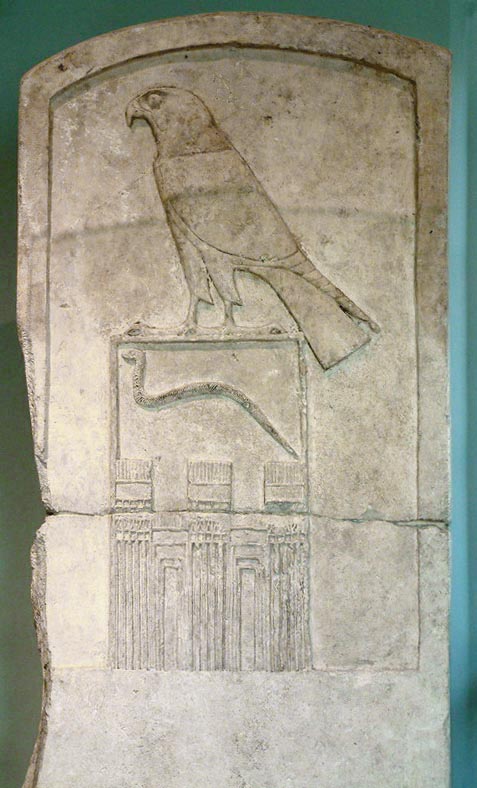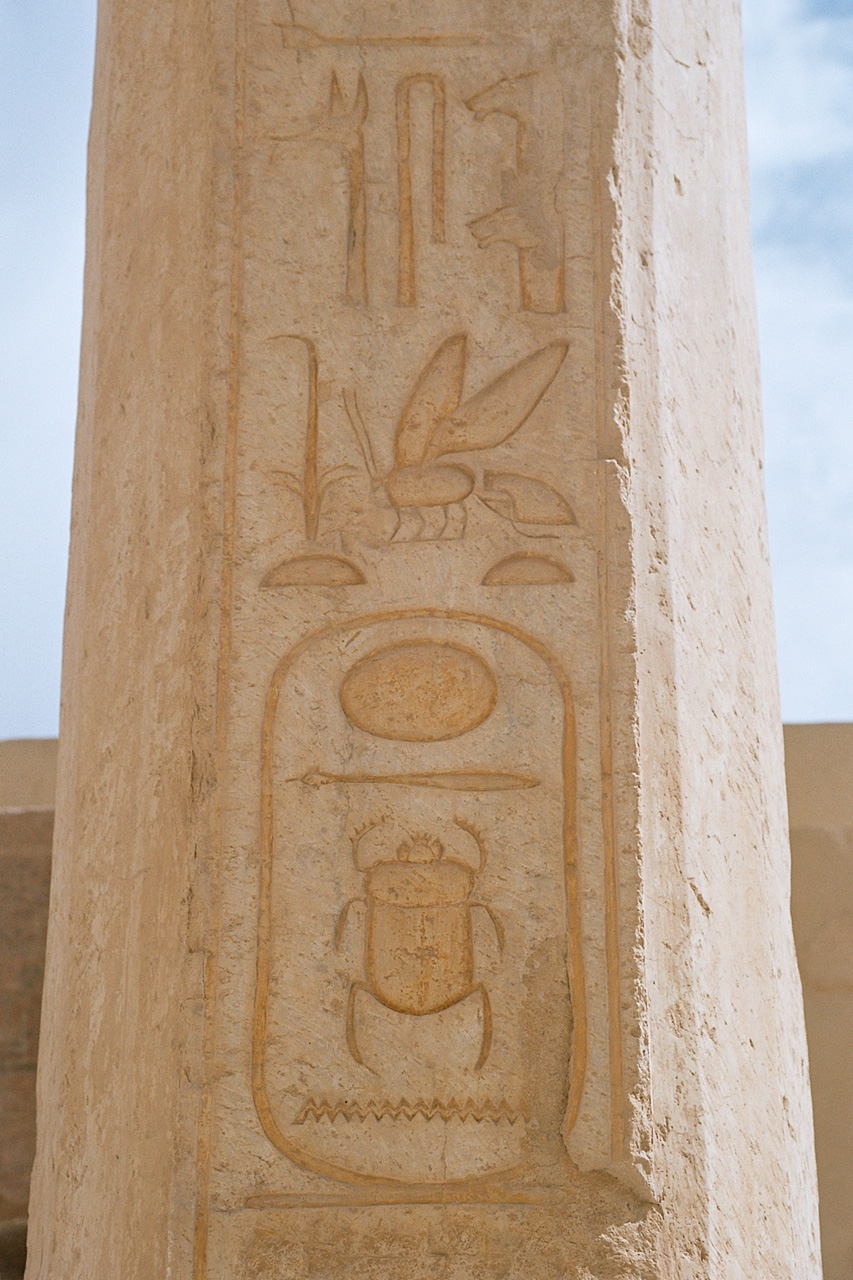Royal Titulary on:
[Wikipedia]
[Google]
[Amazon]
The royal titulary or royal protocol is the standard naming convention taken by the pharaohs of ancient Egypt. It symbolised worldly power and holy might, also acting as a sort of
 The Horus name is the oldest form of the pharaoh's name, originating in
The Horus name is the oldest form of the pharaoh's name, originating in
G16
The Nebty name (lit. " two ladies") was associated with the so-called " heraldic" goddesses of Upper and Lower Egypt:
* Nekhbet, patron deity of Upper Egypt, represented by a vulture, and
* Wadjet, patron deity of
G8
Also known as the Golden Horus name, this form of the pharaoh's name typically featured the image of a Horus falcon perched above or beside the hieroglyph for gold.
The meaning of this particular title has been disputed. One belief is that it represents the triumph of

M23:t-L2:t
The pharaoh's throne name, the first of the two names written inside a cartouche, usually accompanied the title ''
G39-N5:.-
This was the name given at birth. The name itself was preceded by the title "Son of Ra", written with the hieroglyph of a duck (''za''), a homonym for the word meaning "son" (''za''), adjacent to an image of the sun, a hieroglyph for the chief solar deity Ra. It was first introduced to the set of royal titles in the Fourth Dynasty and emphasizes the king's role as a representative of the solar god Ra. For women who became pharaoh, the preceding title was interpreted as "daughter" also.
Modern historians typically refer to the ancient kings of Egypt by this name, adding
ordinals (e.g. "II", "III") to distinguish between different individuals bearing the same name.
The Gold namethe Royal Titulary
an
on Digital Egypt {{DEFAULTSORT:Ancient Egyptian Royal Titulary * Ancient Egyptian language *
mission statement
A mission statement is a short statement of why an organization exists, what its overall goal is, the goal of its operations: what kind of product or service it provides, its primary customers or market, and its geographical region of operation ...
for the duration of a monarch's reign (although sometimes it even changed during the reign).
The full titulary, consisting of five names, did not come into standard usage until the Middle Kingdom but remained in use as late as the Roman Empire.
Origins
In order that the pharaoh, who held divine office, could be linked to the people and the gods, special epithets were created for them at their accession to the throne. These titles also served to demonstrate one's qualities and link them to the terrestrial realm. The five names were developed over the centuries beginning with the Horus name. This name identified the figure as a representative of the godHorus
Horus or Heru, Hor, Har in Ancient Egyptian, is one of the most significant ancient Egyptian deities who served many functions, most notably as god of kingship and the sky. He was worshipped from at least the late prehistoric Egypt until the P ...
. The Nebty name was the second part of the royal titular of Upper and Lower Egypt. This name placed the king under the protection of two female deities, Nekhbet and Wadjet and began sometime towards the end of the First Dynasty as a reference to "The one who belongs to Upper
Upper may refer to:
* Shoe upper or ''vamp'', the part of a shoe on the top of the foot
* Stimulant, drugs which induce temporary improvements in either mental or physical function or both
* ''Upper'', the original film title for the 2013 found fo ...
and Lower Egypt", along with mention of the Two Ladies. Beginning sometime in the Fourth Dynasty of Egypt, the Gold Falcon name (sometimes called the Horus of Gold) was created. The last two names of the king, the prenomen and the nomen, were generally depicted within the circular, roped cartouche of the king (eventually the cartouche would contain all royal names, including the queen and the royal children) and were known as the Throne name and the Son of Re name.
Horus name
𓅃𓊁 The Horus name is the oldest form of the pharaoh's name, originating in
The Horus name is the oldest form of the pharaoh's name, originating in prehistoric Egypt
Prehistoric Egypt and Predynastic Egypt span the period from the earliest human settlement to the beginning of the Early Dynastic Period around 3100 BC, starting with the first Pharaoh, Narmer for some Egyptologists, Hor-Aha for others, with th ...
. Many of the oldest-known Egyptian pharaohs were known only by this title.Toby A. H. Wilkinson: ''Early Dynastic Egypt''. Routledge, London/New York 1999, , p. 74-75.
The Horus name was usually written in a serekh, a representation of a palace façade. The name of the pharaoh was written in hieroglyphs inside this representation of a palace. Typically an image of the falcon god Horus
Horus or Heru, Hor, Har in Ancient Egyptian, is one of the most significant ancient Egyptian deities who served many functions, most notably as god of kingship and the sky. He was worshipped from at least the late prehistoric Egypt until the P ...
was perched on top of or beside it.
At least one Egyptian ruler, the Second Dynasty pharaoh Seth-Peribsen, used an image of the god Set instead of Horus, perhaps signifying an internal religious division within the country. He was succeeded by Khasekhemwy
Khasekhemwy (ca. 2690 BC; ', also rendered ''Kha-sekhemui'') was the last Pharaoh of the Second Dynasty of Egypt. Little is known about him, other than that he led several significant military campaigns and built the mudbrick fort known as Shune ...
, who placed the symbols of both Set and Horus above his name. Thereafter, the image of Horus always appeared alongside the name of the pharaoh.
By the time of the New Kingdom
New is an adjective referring to something recently made, discovered, or created.
New or NEW may refer to:
Music
* New, singer of K-pop group The Boyz
Albums and EPs
* ''New'' (album), by Paul McCartney, 2013
* ''New'' (EP), by Regurgitator, ...
, the Horus name was often written without the enclosing serekh.
Nebty ("two ladies") name
Lower Egypt
Lower Egypt ( ar, مصر السفلى '; ) is the northernmost region of Egypt, which consists of the fertile Nile Delta between Upper Egypt and the Mediterranean Sea, from El Aiyat, south of modern-day Cairo, and Dahshur. Historically, ...
, represented by a cobra.
The name is first definitively used by the First Dynasty pharaoh Semerkhet
Semerkhet is the Horus name of an Early Dynastic Period of Egypt, early Egyptian pharaoh, king who ruled during the First Dynasty of Egypt, First Dynasty. This ruler became known through a tragic legend handed down by the historian Manetho, who r ...
, though it only became a fully independent title by the Twelfth Dynasty.
This particular name was not typically framed by a cartouche or serekh, but always begins with the hieroglyphs of a vulture and cobra resting upon two baskets, the dual
Dual or Duals may refer to:
Paired/two things
* Dual (mathematics), a notion of paired concepts that mirror one another
** Dual (category theory), a formalization of mathematical duality
*** see more cases in :Duality theories
* Dual (grammatical ...
noun "nebty".
Horus of Gold
Horus
Horus or Heru, Hor, Har in Ancient Egyptian, is one of the most significant ancient Egyptian deities who served many functions, most notably as god of kingship and the sky. He was worshipped from at least the late prehistoric Egypt until the P ...
over his uncle Set, as the symbol for gold can be taken to mean that Horus was "superior to his foes". Gold also was strongly associated in the ancient Egyptian mind with eternity, so this may have been intended to convey the pharaoh's eternal Horus name.
Similar to the Nebty name, this particular name typically was not framed by a cartouche or serekh.
Throne name (''prenomen'')

nsw-bity
The prenomen, also called cartouche name or throne name ( egy, 𓆥 nswt-bjtj "of the Sedge and Bee") of ancient Egypt, was one of the five royal names of pharaohs. The first pharaoh to have a Sedge and Bee name was Den during the First Dynasty ...
'' (''nsw(t)-bjt(j)''), traditionally interpreted as " eof sedge ndbee" and often translated for convenience as "King of Upper and of Lower Egypt". (The sedge and the bee symbolised Upper and Lower Egypt, respectively, although recent research has thrown this interpretation into doubt.
Schenkel, Wolfgang (1986) “Das Wort für König (von Oberägypten)” in ''Göttinger Miszellen'', 94, pp. 57-73.
)
The epithet ''nb tꜣwy'', "Lord of the Two Lands", referring to the valley and delta regions of Egypt, often occurs as well.
Personal name (''nomen'')
Examples of the full titulary
Senusret I
In the Middle Kingdom, the full titulary was sometimes written in a single cartouche, as in this example from Senusret I, from Beni Hasan.


Hatshepsut
The full titulary of Eighteenth Dynasty pharaoh Hatshepsut, providing a guide to pronunciation and its equivalent meaning and showing the differences since this pharaoh is a woman, is as follows, *Horus name: ''Wesretkau'', "Mighty of Kas" *Nebty name: ''Wadjrenput'', "She of the Two Ladies, Flourishing of years" *Golden Horus: ''Netjeretkhau'', "Divine of appearance" (''Netjeret'' is the feminine form of ''netery'' meaning 'godly' or 'divine', and ''khau'', 'appearances') *Praenomen: ''Maatkare'', "Truth a'atis the Ka of Re" *Nomen: ''Khnumt-Amun Hatshepsut'', "Joined with Amun, Foremost of Noble Ladies"Thutmose III
The full titulary of Eighteenth Dynasty pharaoh Thutmose III, providing a guide to pronunciation and its equivalent meaning, is as follows *Horus name: ''Kanakht Khaemwaset'', "Horus Mighty Bull, Arising in Thebes" *Nebty name: ''Wahnesytmireempet'', "He of the Two Ladies, Enduring in kingship like Re in heaven" *Golden Horus: ''Sekhempahtydjeserkhaw'', "Horus of Gold Powerful of strength, Sacred of appearance" *Praenomen: ''Menkheperre'', "He of the Sedge and theBee
Bees are winged insects closely related to wasps and ants, known for their roles in pollination and, in the case of the best-known bee species, the western honey bee, for producing honey. Bees are a monophyly, monophyletic lineage within the ...
, Enduring of form is Re"
*Nomen: ''Thutmose Neferkheperu'', "Son of Ra, Thutmose, beautiful of forms"
References
Bibliography
* * * * * * * *External links
The Gold name
an
on Digital Egypt {{DEFAULTSORT:Ancient Egyptian Royal Titulary * Ancient Egyptian language *